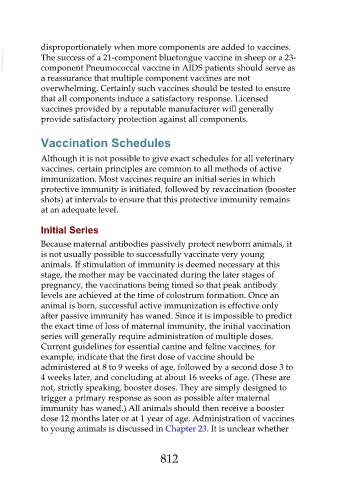Page 812 - Veterinary Immunology, 10th Edition
P. 812
disproportionately when more components are added to vaccines.
VetBooks.ir The success of a 21-component bluetongue vaccine in sheep or a 23-
component Pneumococcal vaccine in AIDS patients should serve as
a reassurance that multiple component vaccines are not
overwhelming. Certainly such vaccines should be tested to ensure
that all components induce a satisfactory response. Licensed
vaccines provided by a reputable manufacturer will generally
provide satisfactory protection against all components.
Vaccination Schedules
Although it is not possible to give exact schedules for all veterinary
vaccines, certain principles are common to all methods of active
immunization. Most vaccines require an initial series in which
protective immunity is initiated, followed by revaccination (booster
shots) at intervals to ensure that this protective immunity remains
at an adequate level.
Initial Series
Because maternal antibodies passively protect newborn animals, it
is not usually possible to successfully vaccinate very young
animals. If stimulation of immunity is deemed necessary at this
stage, the mother may be vaccinated during the later stages of
pregnancy, the vaccinations being timed so that peak antibody
levels are achieved at the time of colostrum formation. Once an
animal is born, successful active immunization is effective only
after passive immunity has waned. Since it is impossible to predict
the exact time of loss of maternal immunity, the initial vaccination
series will generally require administration of multiple doses.
Current guidelines for essential canine and feline vaccines, for
example, indicate that the first dose of vaccine should be
administered at 8 to 9 weeks of age, followed by a second dose 3 to
4 weeks later, and concluding at about 16 weeks of age. (These are
not, strictly speaking, booster doses. They are simply designed to
trigger a primary response as soon as possible after maternal
immunity has waned.) All animals should then receive a booster
dose 12 months later or at 1 year of age. Administration of vaccines
to young animals is discussed in Chapter 23. It is unclear whether
812

